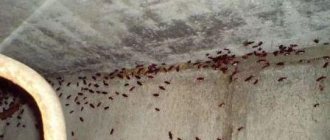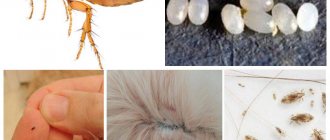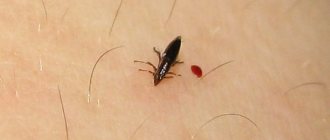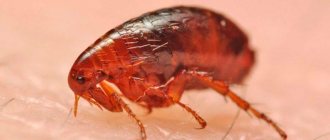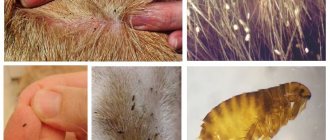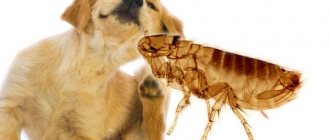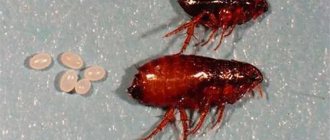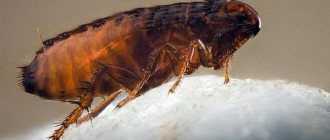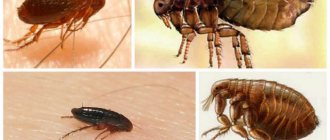Where there are animals, the problem of getting rid of parasites is always relevant. Small bloodsuckers enter along with clothing, brought in from the street. They can also “move” on pets if they come into contact with the external environment and other animals. The treatment needs to be comprehensive so as not to leave the insects a single chance.
This is where the question arises, what composition and what is better to wash wooden and linoleum flooring to get rid of fleas. It is advisable to cure pets once and for all and at the same time remove and isolate intrusive aliens jumping around the floor and home. Practice shows that even such floor treatment seriously reduces the population of bloodsuckers in the house. We give a master class on how to quickly and effectively get rid of fleas at home.
- Features of flea control
- How to deal with genital fleas: methods and means
- Where do they come from?
- Signs of appearance in the house
- Disinsection at home
- Anti-flea solutions for cleaning floors
- What helps you get rid of
- Folk remedies
Features of flea control
Fleas, both jumping on the floor and hiding in the pet’s bedding, directly on his fur, multiply unusually actively. Authoritative sources advise, in addition to treating animals, to use floor cleaning products for fleas. This way, parasites will not be able to move around the house, hide on the floor or in the cracks between the boards.
Otherwise, after successfully curing a dog or cat of fleas, the insects will “suddenly” appear again: all this time they have been hiding in secluded corners, waiting for the right moment for the next attack. How to clean the floor from fleas will become clear later.
Safety measures during disinfestation
When treating premises, you need to take care of protection, since modern insecticidal preparations are highly toxic. It is necessary to work with the products in a respirator, gloves and goggles, while clothing should be made of thick fabric and cover the entire body.
After treatment, you must leave the apartment for several hours until the toxins settle. When you arrive home, you should open the windows and thoroughly ventilate all rooms. When scattering the powder, you need to keep in mind that children and pets can come into contact with it, so before they arrive, you need to get rid of it with a vacuum cleaner.
READ What paints to mix to get pink?
How to deal with genital fleas: methods and means
So what should you do if fleas are jumping on the floor and are visible to the naked eye? How to poison flea colonies of the species Pulex irritans and others in the house? First you need an effective strategy:
- cleaning up accumulations of old things;
- treatment of floors, including the slightest cracks and cavities, baseboards;
- treatment of animals and people.
For a long time it was believed that “animal” bloodsuckers are almost harmless to humans. As it turns out, this is not the case. Flea bites lead to the appearance of ulcers, wounds, and if the animal was infected, serious diseases. Fleas, like cockroaches, actively spread infections and choose dirty places with access to food and cracks in the floors as their habitat. Therefore, at the first stage, a thorough cleaning is carried out using a vacuum cleaner, detergents, and then a chemical attack using insecticides.
And deciding what to wash the floors with to get rid of fleas is not difficult at all. Pet stores have a sufficient range of products for this - powders and ampoules with liquid chemicals intended for washing floors infested with fleas. Among the tested methods are Dichlorvos and its analogues, whiteness. It is very important to treat literally all surfaces that are favorite places for insects to accumulate in a private home, including (upholstered) furniture, carpets or floor coverings. This will be universal advice on how to get rid of underground fleas, their nests and young animals.
Insect habitats indoors
To quickly get rid of cat fleas in the house, you should carefully treat their favorite habitats: baseboards, any cracks, carpets.
If there is a cat in the house, fleas can be found on his bed. Parasites also prefer to be in mattresses, upholstered furniture and toys.
Insects choose places where people visit most often for “hunting”, and secluded corners for breeding.
If you find cat fleas, you should immediately begin exterminating them. If parasites begin to multiply en masse, it will be much more difficult to get rid of them.
On a note. Sometimes fleas bite only one family member. Parasites choose the person who has the most attractive odor to them.
Where do they come from?
There are several ways for fleas to enter a person’s home. More often than others - on carriers - rodents, birds or pets, if they are in contact with the outside world, they go outside. There are also paradoxical cases when insects that jump quite high entered apartments through the entrance or an open window. Well, “on horseback” is the most common way. Out of nowhere, suddenly, insects (fleas) appear on the floor. To do this, you need a carrier, old furniture brought from the dacha or a similar method.
How dangerous are fleas for humans?
Parasites are extremely dangerous. They provoke the development in humans:
- Pulicosis. Skin lesions caused by human flea bites. The bite site swells, sometimes ulcers form around the mouth and throat, and the body itches. Due to the constant stress experienced by the body, the central nervous system is involved in the process, which negatively affects human health.
- Tungiasis. The disease is characterized by the appearance of inflamed skin areas at the site of the bite. The body itches and hurts, the skin peels. Most often, the disease occurs in tropical regions.
In addition, parasites carry:
- plague;
- leprosy stick;
- Marseilles fever;
- brucellosis;
- mouse and rat tapeworm.
We suggest you familiarize yourself with How to wash linoleum after repair.
The degree of danger depends on the type of parasites. Apartments and private households are most often inhabited by human, dog and cat fleas. But there are many other varieties of these insects in the world. Thus, the Tien Shan flea, settling in the fur of domestic animals, mainly cattle, often causes emaciation and even death of the individual on which it parasitizes.
The appearance of blood-sucking insects should be taken very seriously. The fact is that fleas feed on blood. The supplier of “food” can be not only dogs, cats, birds, rodents, but also people. What is the danger of bites from these parasites for humans?
- First of all, these are unpleasant painful sensations, itching, redness of the skin.
- An allergic reaction to the bite, a significant increase in temperature and swelling at the wound site are possible.
- Fleas can be carriers of infections such as hepatitis B and C, typhus, encephalitis and other serious diseases.
- There is always a risk of infection with various types of worms, salmonellosis, nematodes or various fungal infections.
- You can expect very big troubles from rat fleas, which include pseudotuberculosis, melioidosis, myxomatosis, etc.
- In addition, constantly thinking about insects and expecting bites can turn into a phobia or cause a nervous breakdown.
Small (up to 0.5 cm) black or brown insects are hardly noticeable in an apartment until they begin to bite a person. The blood of warm-blooded creatures is the only source of nutrition for fleas. Insects cannot live on the human body, but they feel great in animal fur. The body of the parasite, elongated and compressed on both sides, is ideal for moving in the pile of carpets and the fur of cats and dogs.
Thanks to its long hind legs, the insect can jump in length and height to a distance that allows it to easily bite a person’s ankles. Painful bites are dangerous for the development of infectious inflammation and allergies. In addition, parasites are capable of spreading plague and dozens of other deadly diseases.
Signs of appearance in the house
There are not many of them, but the signs are quite characteristic, they are difficult to misinterpret. A cat or dog begins to scratch in a specific way, the animal becomes nervous and behaves restlessly. People develop small, itchy sores or sores (sometimes painful).
When the flea population reaches a critical limit, they begin to actively move along the floor, carpeting, and upholstered furniture. Around the same time, they become noticeable on the pet’s skin and on the floor. Any of these signs requires immediate intervention.
Boric acid for fleas
Boric acid is a low-toxic inorganic mineral with insecticidal, fungicidal and herbicidal properties. Serves as the basis for a number of commercial pest control products. Boric acid causes loss of moisture in the body of insects, dehydration occurs, and the insect dies.
It does not emit an odor and therefore does not repel, but kills fleas, maintaining an insecticidal effect for a long time.
Boric acid is used as follows:
- Remove toys and other things from the floor of the room being treated
- Vacuuming your carpets to remove dirt and dust will improve the quality of the finish. If necessary, do wet cleaning
- Sprinkle boric acid powder onto carpets and rugs, paying special attention to areas where your pet spends time.
- Using a brush, spread the powder evenly over the carpet
Boric acid kills flea larvae, but has a weak effect on adult fleas, so a noticeable result will appear in 2-6 weeks, until the adult population dies. 48 hours after treatment, clean with a vacuum cleaner. Although boric acid is a long-lasting treatment, repeated treatments will be required.
Boric acid has almost no side effects, except for mild skin and eye irritation. Use in the garden is not recommended due to toxicity to beneficial plants and birds.
Disinsection at home
You can, of course, turn to professional exterminators to get rid of the unwanted neighborhood, but there is also a less expensive way to relieve the flea siege. There are not many main directions for fighting insects:
- The animals themselves, which are to be treated with chemicals, shampoo, drops.
- Everything that is in contact with the floor - linoleum, carpet, rugs.
- Furniture, accumulations of old things in which insects create nests.
All vectors will have to be acted upon simultaneously so that fleas do not get a chance to hide, wait out the threat, or hide in a crack in the floor or under the baseboard.
Chemical method
The range of products for killing cat fleas is quite wide. There are various aerosols, sprays and concentrates made from natural and synthetic components on sale.
To get rid of cat fleas in apartments, use the following insecticides:
- Pyrethrin is a natural insecticide obtained from plant materials. Forces parasites to leave the apartment, and the remaining insects die after a few days from suffocation. Safe for people and animals.
- Permethrin is a synthetically reconstituted pyrethrin that has a more pronounced effect. Causes paralysis in insects.
- Benzyl benzoate is an ester of benzoic acid. Insecticide safe for humans.
- Fipronil is a synthetic substance with a powerful insectoacaricidal effect.
- Piperonyl butoxide and chlorpyrifos are auxiliary components that enhance the effect of the main substance.
Cat fleas can develop resistance to one or another insecticide. To get rid of these insects forever, it is better to periodically change the medications.
Aerosols and sprays
Aerosols act locally and allow you to locally get rid of cat fleas in your apartment. Massive death of insects can be noticed already during treatment. These products are easy to use and contain flavorings - you don’t have to suffer from a pungent odor.
The disadvantage of sprays and aerosols is their high consumption. To get rid of cat fleas in a 1-room apartment, you will have to spend 2-3 cans. And if you consider that you need to destroy parasites regularly, it turns out to be quite expensive.
To get rid of cat fleas, use the following means:
- Pair Stop;
- Raptor;
- Raid;
- Leopard;
- Dichlorvos;
- Canina pharma;
- Frontline;
- Beafar;
- Battalion commander
Important. A cat or other pet should not be treated with a flea killer in an apartment. The concentration of active substances in it is too high - the animal can be poisoned.
Processing method
To get rid of cat fleas in residential areas, the Para Stop aerosol is most often chosen. It destroys adult insects, larvae and pupae. If the instructions and safety precautions are followed, the aerosol does not harm people or pets.
Before treatment, the apartment is wet cleaned, all family members, animals, terrariums and aquariums are evacuated. Food products are placed in sealed containers.
The product is available in the form of an aerosol generator, which ensures uniform spraying. Before use, shake the can vigorously, then turn it upside down and point it at the surface to be treated. The product is sprayed from a distance of 50 cm.
To get rid of cat fleas in an apartment, spray furniture, the space under beds and carpets, as well as all hard-to-reach places: crevices, cracks, baseboards. To treat 1 m2, it is enough to spray the product for 5 seconds.
After application, the apartment is left closed for 3 hours, then ventilated for at least 30 minutes.
The home is vacuumed daily for a week - with this measure you can quickly get rid of parasites. Vibration and warm air currents accelerate the removal of cat fleas from pupae, and Para Stop continues to destroy them.
Important. The dust container is always emptied outside the home to prevent re-infestation by parasites.
Concentrates
They are a liquid with a high content of active substances. Such products are not used in their pure form. A working solution is first prepared from them - diluted in the proportion specified by the manufacturer. These are the drugs that exterminators most often use.
To get rid of insects, concentrates are used to treat all surfaces in the apartment, not just hidden places. Typically, cat fleas die en masse 5-7 days after use, but some brands of products work faster. After disinfestation, the drugs continue to act for about another month.
Butox is recognized as one of the most popular and effective remedies. From 1 ml of concentrate, 500-750 ml of working solution is obtained. The only drawback is the rather strong specific smell.
You can also get rid of cat fleas in your apartment using the following means:
- Ektosan - diluted in the same concentration as Butox. The product does not smell so strong and does not leave marks on furniture, carpets and other coverings.
- Neostomozan - to prepare a working solution, dissolve 1 ml of concentrate in 1 liter of water. The protective properties last for about a week. The disadvantages include a very pungent odor.
- Delcid concentrate is diluted at the rate of 1 ml per 800 ml of water. Insects die within a couple of hours after using the emulsion. The drug has a weak specific odor that quickly disappears.
- Tsifox – 1 liter of water will require 2 ml of the drug. Effective only against adult insects. Causes paralysis in cat fleas after 30 minutes. It continues to repel insects for 3-4 months. It has a weak odor that does not linger on surfaces.
- Executioner – 1 bottle of 5 ml is designed to prepare 0.5 liters of working solution. The effect appears within 2 hours. The unpleasant odor goes away quickly when aired.
- Get – diluted in a ratio of 1 to 10 (100 ml per 1 l). Does not have a pronounced odor. All insects die within a week. The effect lasts for six months. The manufacturer claims that cat fleas do not develop immunity to this product.
- Tetrix – 50 ml of concentrate is dissolved in 1 liter of water. The composition contains potent poisons, so not only adult fleas and larvae die, but also eggs. However, the drug is also toxic to humans. Do not allow it to enter the respiratory tract, mucous membranes or skin.
- Cucaracha - 2.5 ml of the drug is diluted in 1 liter of water. Has a long-lasting effect: the active substances continue to work for 30 days after application. The disadvantage is an unpleasant odor that lasts for quite a long time.
- Agran - to prepare 1 liter of working solution you will need 3 ml of concentrate. The composition includes 2 poisons (chlorpyrifos and cypermethrin). There is no information yet about insects with immunity to these substances. It has a pungent odor.
- Tsifox - if there are few parasites, it is enough to mix 0.4 ml of concentrate with 1 liter of water. Otherwise, 2 ml will be required. Cat fleas begin to die 30 minutes after treatment. The drug continues to act for 3 months.
- Biorin - 1.2 ml of concentrate is diluted in 1 liter of water. Within 15 minutes after treatment, 50% of fleas are destroyed, the rest die within 24 hours. The duration of protection is 6-8 weeks.
- Sinusan - working solution is made in a ratio of 5 ml per 1 liter of water. Duration of exposure is approximately 1 month. The product has a weak specific odor.
- Chlorpyrimark - used at the rate of 5 ml per 1 liter of water. Residual activity appears over 1.5-2 months. Contains fragrances that neutralize unpleasant odors.
- Empire-20 - diluted in a ratio of 1 to 50. That is, to prepare 1 liter of working solution you will need 20 ml of the drug. Initial signs of poisoning appear in insects 2-4 hours after contact. The death of parasites increases over the course of 3 days. The duration of residual impact is more than 30 days.
- Eslanadez – add 4 ml of concentrate to 1 liter of water. The action lasts up to 45 days. The smell is weak and disappears quickly.
- Averfos – 5 ml of concentrate is required for 1 liter of water. The effect lasts for a month. It has a specific smell, but after airing it disappears.
- Taran - working emulsion is prepared at the rate of 1.25 ml per 1 liter of water. The drug begins to act within 15 minutes. In insects, activity first increases, then paralysis and death occur. The residual effect lasts for 4-8 weeks.
To get rid of fleas in an apartment, use only freshly prepared working solution. During storage, it erodes and loses its properties.
Processing method
You can get rid of annoying parasites for a long time only if you treat your apartment according to certain rules.
Pre-clean the room:
- wipe off dust even in the most difficult to reach places;
- vacuum, capturing all the cracks and furniture;
- washing the floor.
The cat's bedding is boiled, and bedding, bedspreads, blankets, toys, curtains and other things that may contain cat fleas are washed at temperatures above 60°C.
After this, the working solution is applied.
Important. Before treatment, you need to check whether the anti-cat flea product stains wallpaper and fabrics. Otherwise, you can damage the walls and upholstered furniture.
To spray the chemicals you will need a spray bottle. You can buy it at a hardware store or use the one left over from another product. For example, for washing windows.
The insecticide in the apartment is treated with:
- carpets;
- baseboards;
- upholstered furniture;
- doors and walls (approximately 1.2 m from the floor).
If the cat often climbs onto bookshelves, cabinets and other “high places”, then you will have to spray them too.
100-200 ml of working solution is sprayed onto 1 m2. After applying the product to all surfaces, close the apartment and leave for about 2 hours. You cannot be inside at this time - inhaling toxic fumes is harmful to health. If there are other pets in the house - hamsters, parrots, snails, they are given to relatives or neighbors.
After the specified time, the room is well ventilated. Places with which apartment residents are constantly in contact are wiped with a damp cloth. There is no need to wash other surfaces.
To completely remove parasites, the apartment is treated every 10-12 days.
Security measures
When working with chemicals, take minimal precautions: wear gloves, safety glasses and a respirator, and do not allow the product to come into contact with mucous membranes.
During treatment, smoking, drinking and eating are prohibited. At the end of work, you must thoroughly wash your hands and face with soap and rinse your mouth with water.
In case of contact with skin, wash off with plenty of water. If the drug is swallowed, drink 2-3 glasses of clean water and 8-10 tablets of activated carbon or other sorbent. If weakness, nausea, or dizziness occur, consult a doctor.
Anti-flea solutions for cleaning floors
This includes not only special formulations, but also any proven methods of getting rid of fleas on the floor. In pet stores you can find insect growth regulators (blockers), powders (Diatomite), and sprays. There are also industrial emulsions intended for removing parasites from cattle - oily, water-soluble liquids.
Finally, you can dilute zoo shampoo in warm water and wash the floor with this mixture. Laundry soap, cut with a knife and dissolved in a bucket of water, will also work. It all depends on the degree of damage to the home and floor by fleas. After cleaning, all waste, dry and liquid, must be destroyed so as not to give bloodsuckers a second chance to enter the house.
Vinegar for fleas in the apartment
Vinegar is used in everyday life for cleaning and odor removal, to remove ants in the kitchen, and in the garden as an insecticide and herbicide. Vinegar is known as a deodorizing agent for dogs and cats and, of course, as a folk remedy for fleas. In this case we are talking exclusively about apple cider vinegar! Apple cider vinegar does not kill fleas, but it does create an inhospitable environment that drives them out.
“Both fleas cannot tolerate the smell or taste of vinegar, which means they will not stay on an animal that smells like apple cider vinegar. Vinegar is more suitable as a preventative rather than a therapeutic agent for animals."
Darcy Matheson, Greening Pet Care
Dousing a bottle of apple cider vinegar on your dog will not magically make the fleas disappear. There are many known uses for this natural repellent, for example, as an additive to drinking water, in the form of a spray or a bath.
- Bath: Mix 1 cup of apple cider vinegar and 1 liter of warm water and treat your pet with the resulting solution.
- Drinking water: Add a teaspoon of apple cider vinegar to 1 liter of water and stir. Your pet will not like the drink at first, but over time he will start drinking it.
- Spray: Mix two cups of water and two cups of apple cider vinegar. Pour the solution into a spray bottle and thoroughly treat the animal with the solution from head to tail and do not rinse, the smell of vinegar will disappear as soon as the fur dries.
Folk remedies
Simple, but effective, and without side effects. Fleas do not like sharp, pungent odors or aromatic oils that clog their spiracles. Therefore, the following folk remedies are recommended for treating floors:
- Collections of wormwood, cloves, celandine and tansy, which are available in pharmacies, are infused for 12 hours. You will need to take 2 tablespoons of each component. The finished mixture, settled and strained, is thoroughly sprayed onto the floor surface.
- Sprinkle the mixture of salt and baking soda on the floors, carpets and surfaces. After a day, clean with a vacuum cleaner. Fleas, including adults and larvae, will also leave with the composition.
- Peppermint, lavender, eucalyptus oil. It is permissible to use fresh bunches of plants, placing them on the floor in all problem areas.
Tar soap for fleas
The composition of tar soap includes sodium salts, citric acid, table salt, thickeners and the main component - birch tar.
Tar is a thick black liquid with a pungent odor and bactericidal, anti-inflammatory and insecticidal effects. Tar soap relieves itching and irritation. This is a natural folk remedy and it is inexpensive.
Tar is available in the form of solid and liquid soap, as well as shampoo. It is more convenient to treat pets with liquid products. But if you use hard soap, then first soak the bar of soap in water until foam forms. Tar soap is also used for washing floors, treating walls and washing pet accessories against fleas.
However, the use of tar soap requires moderation. According to a study by the New Zealand Skin Diseases Association, there was an increased risk of skin cancer associated with the use of tar soap in animals, but there was no effect on humans.
Video “Bathing a cat with tar soap”
Insecticidal preparations for pets
It will not be possible to completely destroy fleas without treating pets, since insects can hide in the fur of animals after disinsection of a living space. For the procedure, it is recommended to use special products that will not harm the pet, but will be harmful to fleas.
Main types of funds
Today, many different means have been developed that can quickly and effectively kill fleas that parasitize pets:
- insectoacaricidal powder (for example, “Clandestine”) is the most gentle preparation, since the percentage of insecticides in its composition is minimal. The advantages of this remedy include the fact that the animal does not need to be wet, because many tailed animals do not like this. The disadvantage is the short validity period (about 7–10 days),
- anti-parasitic shampoo - suitable for animals that like to bathe. The most popular and inexpensive drugs are: “Bars”, “Clandestine”, “Fitoelita”,
- sprays. These drugs are no less popular, because they are very easy to use. To do this, simply spray the product over your pet's fur and let it dry. The most famous and inexpensive drugs of this type include: “Foline”, “Bars”, “Hartz”,
- flea drops occupy a leading position because they are easy to use and give a long-lasting effect (“FleaNet”). Each package is designed for a certain weight of the animal, so the owner does not have to worry about an overdose.
To avoid re-infestation, after treating your pet, put on an anti-flea collar (for example, “Doctor Zoo”), which will repel parasites.
Photo gallery: antiparasitic agents for animals
Anti-flea collar "Doctor Zoo" is used to protect animals from fleas
Flea spray "Foline" is sprayed over the animal's fur and allowed to dry.
Antiparasitic powder “Clandestine” is the most gentle insecticidal agent
Flea drops "BlochNet" are applied to the withers of the animal
Pyrethrum for fleas
Pyrethrin is a natural insecticide obtained from the raw extract of the chrysanthemum (Pyrethrum). It has been used for pest control since ancient times and is considered safe. Pyrethrum is available in powder or spray form. Pyrethrum is a neurotoxic insecticide. It is also known to have insect repellent properties. Used as a base ingredient in a number of commercial flea and tick products, mainly powders and sprays.
Bleach for fleas
The fight against fleas often drags on for a long time. This is because most flea treatments do not kill eggs. The final extermination of the population requires exposure to all life stages of flea development. Bleach is suitable for killing eggs. Treat carpets and pet habitats with a solution of bleach and water. Add chlorine bleach when washing pet accessories.
But this method requires extreme caution. Chlorine is toxic if ingested, so do not allow your animal to come into contact with the treated surface. When treating carpets and textiles, keep in mind that bleach acts as a bleach.
